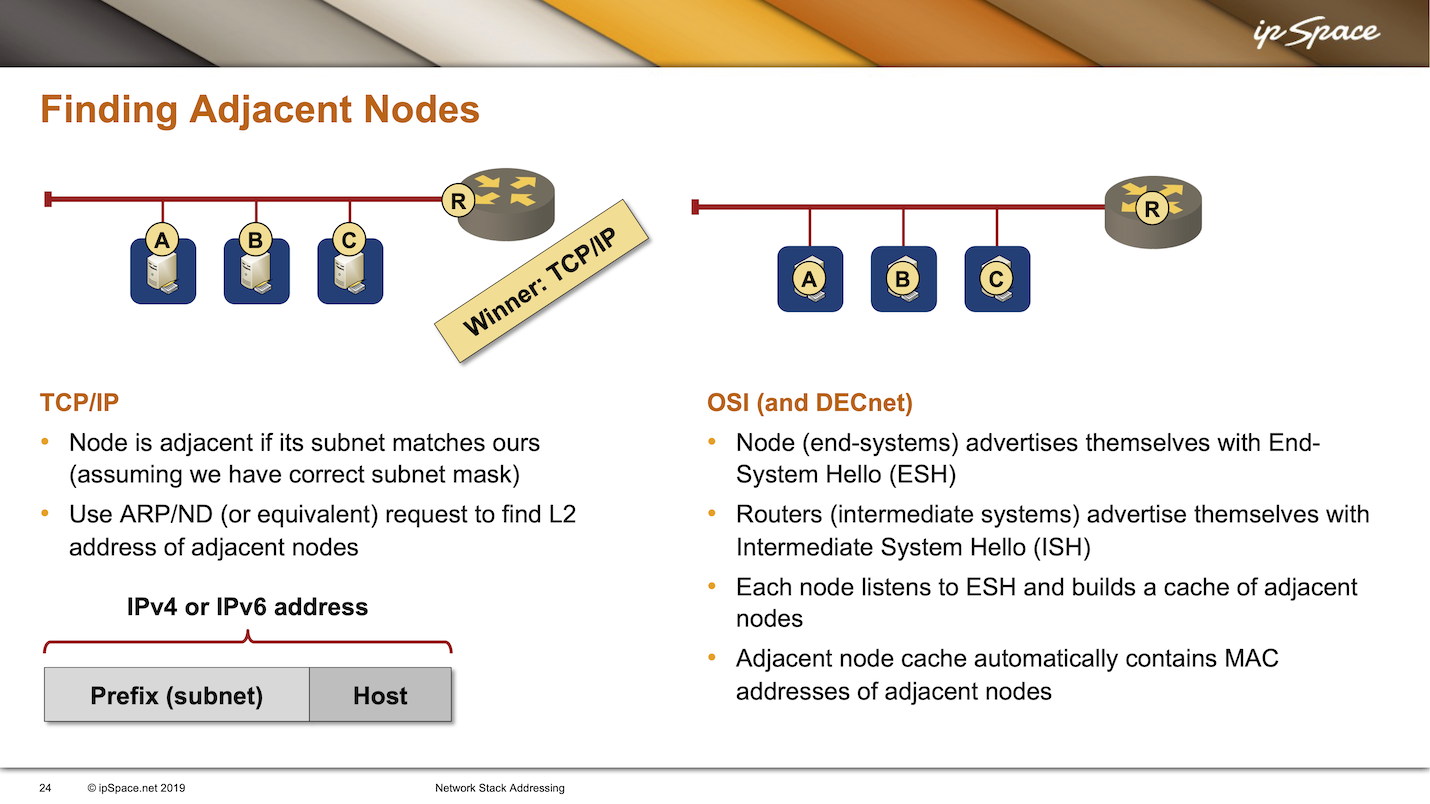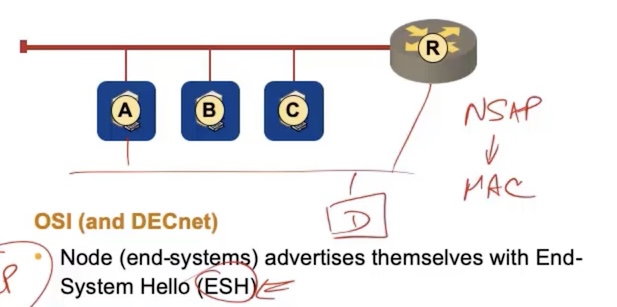Comparing IP and CLNP: Finding Adjacent Nodes
Now that we know a bit more about addresses in a networking stack (read the whole series) and why CLNP uses node addresses while TCP/IP uses interface addresses, let’s see how they solve common addressing problems like finding adjacent nodes.
Let’s start with the elephant in the room: how do you know whether you can reach a host you want to communicate with directly? In the following diagram, how does A know whether B is sitting next to it?

Next question: How do we reach the destination IP address? We need to use a protocol that (given the destination IP address) will find the destination MAC address, which we can use in the layer-2 encapsulation header to send a packet to the destination host. IPv4 uses ARP on LAN media to get that done, and IPv6 uses Neighbor Discover (ND, part of ICMPv6)1.
You don’t need ARP or ND on a layer-2 point-to-point link2 because you already know the data link layer address to use for the other guy. For example, in the Early Data-Link Layer Addressing blog post, we mentioned that the destination MAC address on a PPP link is always 0xFF (the broadcast address). As we know the destination MAC address, we don’t do ARP on PPP or any other point-to-point serial link3 (IPv6 might still perform Neighbor Discovery).
OSI (CLNP) took a completely different approach than TCP/IP because the CLNP network address (NSAP – Network Services Access Point) belongs to a node, and a node could have multiple interfaces. You can’t use part of the destination network address to determine whether the node is adjacent to you. To solve that problem, every CLNP node sends hello messages – hosts send End-System Hellos4(ESH), and routers send Intermediate System Hellos5(ISH) – advertising their NSAPs.
Each CLNP node on a LAN segment would listen to all hello messages other nodes send on that segment and build a cache of adjacent NSAP addresses. In our example, A would know that B is adjacent because it would see the ESH message from B. Likewise, assuming there’s another link connecting A and D (see the following diagram), A would know that D is adjacent (but on a different interface) after it would receive an end system hello from D. Similarly, B would know that D is not adjacent because it has never seen an ESH from D.

Adding another link and another node to the CLNP network
Finally, to make forwarding decisions and send packets, we need more information in the neighbor cache than the neighbor NSAPs. As you see in the case of host A, the neighbor cache entries must contain outgoing interfaces. We also need the destination MAC addresses, which are trivial to collect. The Hello messages contain the MAC address of the sender, and the CLNP nodes can use them to build the mapping between the adjacent NSAPs and layer-2 addresses.
Effectively, the CLNP neighbor cache is functionally equivalent to host routes pointing to interfaces and MAC addresses.
Off-Topic: ARP and Virtual Machine Mobility
In data centers using server virtualization, we often deal with virtual machines that move willy-nilly across the data center fabric. It would be convenient if the virtual machine could advertise itself after being moved so that everyone would know that the VM MAC address is now elsewhere. That would work out of the box with CLNP, but unfortunately, we don’t have a similar mechanism in IP.
IP hosts have a mechanism called gratuitous ARP, where a host sends a broadcast ARP response announcing a new mapping between its IP address and MAC address (hosts use that when their IP- or MAC address changes). Still, that’s not the same as the periodic host-generated hello messages.
Many hypervisors track the virtual machine MAC- and IP addresses and send fake gratuitous ARPs after a VM has moved, but IP was not designed to be used that way. Virtualization vendors that tried to keep their investment in the networking stack to an absolute minimum (VMware comes to mind) are not listening to ARP requests and replies. Thus, they cannot generate gratuitous ARPs when the VM is moved.
However, VMware figured there was another totally obsolete protocol called Reverse ARP (defined in an RFC from 1984 that nobody has used for decades. RARP packets have only MAC addresses but no IP addresses, and as VMware ESXi knows the VM MAC address, it can generate an RARP packet on behalf of the VM after a VM has moved.
-
In the past, we used static configuration and other ARP-like protocols, but in 2024, almost everything looks like LAN media. ↩︎
-
True point-to-point links are rare in the days of ubiquitous Ethernet and WiFi. What looks like a point-to-point link might be an Ethernet LAN segment that still needs MAC addresses to work correctly. ↩︎
-
Switched WAN technologies like X.25, Frame Relay, and ATM used a different mechanism. On X.25 and ATM, we had to specify the mappings manually. On Frame Relay, once you have configured a virtual circuit (DLCI), you can figure out the remote router’s IP address with Inverse ARP. If you ever encounter these technologies outside a museum or a historical recreation, it might be time to switch jobs. ↩︎
-
OSI terminology for hosts ↩︎
-
OSI terminology for routers ↩︎

Why would IP be the "winner" for finding adjacent nodes?
To send traffic, both IP and CLNP build a "kind of" ARP table (let's say "neighbor" table). IP needs to check network mask before looking at this "neighbor" table. CLNP can use it directly => looks better to me.
But what if there are a LOT of nodes in a segment? IP doesn't need to keep track of nodes it doesn't communicate with => can a good point Must CLNP keep track of every nodes? Can it send ES-ES requests like ARP?
Scalability in large segments. IP nodes communicate only when they must, and the adjacency rules are predefined. CLNP nodes have to maintain soft state through periodic refreshes.
It's like SR-MPLS with a PCEP controller versus MPLS-TE with RSVP.
Are there any OSes that have a CLNS stack for hobbyists to play with? I can't seem to find one for Linux. I personally find poking old network stacks fascinating.
Cisco IOSv probably still has it. There's also this project (but it seems to be abandonware):
https://github.com/crazoes/clnp
This article does a fantastic job of breaking down the complexities of TCP/IP and CLNP in addressing and adjacent node identification. It’s insightful to see how each protocol approaches the issue differently, with TCP/IP using subnet masks and ARP, while CLNP relies on Hello messages to build neighbor awareness. The discussion around ARP and RARP for virtual machine mobility in data centers is especially relevant for those working with virtualization, offering practical insights on the limitations of IP in modern networking setups. Overall, it’s a great resource for anyone interested in deepening their understanding of network protocols and addressing challenges